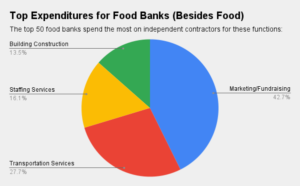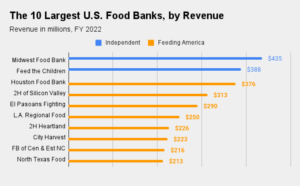The standard answer to the question of how many food banks there are is 200, but actually there are many more. Food Bank News counts at least 371.
[For our latest information on the full scope of the food banking sector, please see our 2021 Directory of the Top 300 Food Banks.]
Two hundred is a great starting point because it’s the number that Feeding America, the nation’s largest hunger-relief organization, touts on its website. In fact, the number of food banks in Feeding America’s nationwide network is exactly 200, including one in Puerto Rico. The primary job of these food banks is to get food out to an estimated 60,000 food pantries, agencies and programs across the country, which ultimately make the food available to individuals struggling with food insecurity.
In addition to the 200 food banks, there are 77 “partner distribution organizations,” or PDOs, on Feeding America’s list. Although these partner distribution organizations are not termed food banks by Feeding America, they actually are food banks, doing the exact same job of primarily acquiring and warehousing food, and then distributing it to food pantries. Most of the partner distribution organizations refer to themselves as food banks and, like food banks, they also run anti-hunger programs like mobile food pantries, weekend and summer food for kids, nutrition education, and senior food boxes.
While the partner distribution organizations are presumably mostly smaller in scale than the 200 food banks, their impact is not trivial. Collectively, they push out millions of pounds of food to pantries and engage in numerous noteworthy programs aimed at solving hunger. A quick spot-check of a few websites reveals, for example, West Alabama Food Bank’s “5th Quarter” program, in which volunteers rescue unused prepared food from all University of Alabama home games, Chester County (PA) Food Bank’s on-staff farmer, and Healthy Harvest (VA) Food Bank’s food pharmacy program providing fresh produce, nutrition education and cooking classes to diabetic and other patients.
In addition to Feeding America’s 200 food banks and its 77 partner distribution organizations, there are at least 53 food banks that operate independently of Feeding America. About ten of these are tiny, serving about ten pantries or fewer. About half of the rest are on the smaller side, distributing food through networks of 100 pantries or less, while the remaining are sizable, working with networks of up to a few hundred pantries. One, Midwest Food Bank, is a behemoth, distributing food to 1,700 pantries via food banks it operates in ten locations. The independent food banks identified by Food Bank News so far include:
Independent Food Banks
- Agape Food Bank, FL
- Anne Arundel County Food Bank, MD
- Bellingham Food Bank, WA
- Billings Food Bank, MT
- Chesterfield Food Bank, VA
- Coastal Harvest, WA
- Community Action Services & Food Bank, UT
- Community Action of Napa Valley, CA
- Community Action Partnership of San Bernardino County, CA
- CUMAC, NJ
- Daily Bread Ministries, TX
- Des Moines Area Religious Council, IA
- Emergency Food Bank Stockton/San Joaquin, CA
- Emergency Food Network, WA
- Farm Share, FL
- Feed the Children, OK
- Food Bank Network of Somerset County, NJ
- Food Bank of El Dorado County, CA
- Food Bank of Nevada County, CA
- Food Bank of Southern California, CA
- Gallatin Valley Food Bank, MT
- Great Falls Community Food Bank, MT
- Hamilton County Harvest Food Bank, IN
- Hays County Food Bank, TX
- Hunger Task Force, WI
- Hunger Network, OH
- Interfaith Food Bank of Amador County, CA
- Jacobs & Cushman San Diego Food Bank, CA
- Kalamazoo Loaves & Fishes, MI
- Kauai Food Bank, HI
- Kings Community Action Organization, CA
- Loaves and Fishes, NC
- Manna Food Center, MD
- Merrimack Valley Food Bank, MA
- Midwest Food Bank, IN
- Northwest Harvest, WA
- Nourish Pierce County, WA
- Operation Food Search, MO
- Orange County Food Bank, CA
- Palm Beach County Food Bank, FL
- Seagate Food Bank, OH
- Share Food Program, PA
- Southeast Alaska Food Bank, AK
- Sunshine Division, OR
- The Food Bank of Lower Fairfield County, CT
- The Food Bank of Manatee, FL
- The Food Basket, HI
- The Food Group, MN
- Twelve Baskets Food Bank, MS
- Wayside Food Programs, ME
- West Side Food Bank, CA
- York County Food Bank, PA
- 360 Communities, MN
In addition to the 200 Feeding America food banks, the 77 partner distribution organizations and the 53 independent food banks, there has emerged a new breed of food bank highly focused on food rescue. These food-rescue organizations — there are at least 37 of them — do not rely on non-perishable food from grocers or manufacturers to fill their inventory. Rather, they have optimized their organizations to rescue fresh food, often produce, and distribute it quickly so it can be consumed before going to waste. While some have warehouses for temporary storage, many operate in a decentralized fashion, relying on volunteers to immediately acquire and distribute food, eliminating the need to store it.
The food-rescue orgs, one of which is affiliated with the Feeding America network, carry out their missions in multiple ways, including by rescuing fresh food from produce wholesalers, restaurants, farms, backyard gardens, farmer’s markets, catered events, and/or community gardens. Often, the food-rescue operations also have an underlying interest in strengthening local food systems. Increasingly, many of the ideas and methods of the food-rescue organizations are also being incorporated into the operations of more traditional food banks. The food-rescue outfits identified by Food Bank News so far include:
Food-Rescue Organizations
- 412 Food Rescue, PA
- Borderlands, AZ
- Boston Area Gleaners, MA
- Boulder Food Rescue, CO
- Capital Roots, NY
- Community Solidarity, NY
- Extra Food, CA
- Farmer Foodshare, NC
- Farmshare Austin, TX
- Feed Spokane, WA
- Feeding America’s Regional Produce Cooperatives, IL
- Food Forward, CA
- Food Recovery Network, MD
- Food Rescue US, CT
- Food Runners, CA
- Food Source DFW, TX
- Free the Need, CA
- Fresh Approach, CA
- Fresh Truck, MA
- Hidden Harvest, CA
- Hungry Harvest, DC
- Keep Austin Fed, TX
- La Soupe Cincinnati, OH
- Loaves and Fishes, CA
- Lovin Spoonfuls, MA
- Nashville Food Project,TN
- Peninsula Food Runners, CA
- Replate, CA
- Salvation Farms, VT
- Saving Grace Perishable Food Rescue, NE
- Second Helpings, IN
- Second Helpings Atlanta, GA
- Society of St. Andrew, VA
- Sustainable Food Center, TX
- Table to Table, NJ
- Waste Not, AZ
- White Pony Express, CA
In addition to the 200 food banks, the 77 partner distribution organizations, the 53 independent food banks and the 37 food-rescue orgs, a handful of organizations exist to prepare meals and deliver them directly to clients, mostly the elderly and disabled. Meal prep and delivery is becoming increasingly relevant in the food banking world as more food banks, including Greater Chicago Food Depository, FeedMore WNY and Feed More (VA), incorporate those activities alongside their standard pantry distributions. Organizations primarily focused on meal prep and delivery include:
Meal Prep and Delivery
- Citymeals on Wheels, NY
- DC Central Kitchen, DC
- God’s Love We Deliver, NY
- Meals on Wheels America, VA
Taken together, Food Bank News figures there are at least 371 organizations across the U.S. largely fulfilling the basic role of acquiring perishable or non-perishable food and redistributing it to food-insecure individuals. This number of course does not include the estimated 60,000 food pantries, agencies and programs that act as intermediaries, obtaining food from the various food banks or rescue organizations and making it directly available to the food-insecure.
Does it matter that there are many more organizations directly involved in getting food to food-insecure individuals than widely thought? Maybe not. “This is a nomenclature issue,” said Joel Berg, CEO of Hunger Free America. On the other hand, not having a full picture of the size of the charitable food system may perpetuate false impressions about the scale of hunger. Noted Alison Cohen, senior director of programs at WhyHunger, “It’s important in terms of the general public knowing the extent to which private non-profits are fulfilling a role that WhyHunger would say should be filled by the state.”
Is your organization missing from this list? Let us know! Email Chris Costanzo at chris.costanzo@foodbanknews.org.










